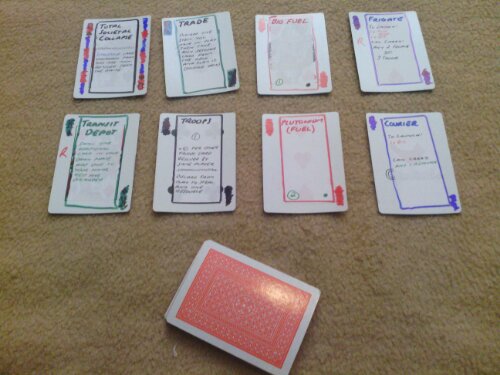So I knew what I wanted my game to do and I was fairly sure that I had figured out how I could make it work. Of course the only way to find out was to try it out and to do that I needed to build the deck. Twice.
The first build happens on paper. A big list of all the cards with all sorts of scribbles and notes and rewrites. I started with the spaceship cards as they were to be the crux of the game; everything else would either be fuel for the ships or cargo for the ships or something to help or hinder that process. I could tell that getting the fuel requirements and cargo loads of each ship was going to take time and a lot of tweaking to get it just right. If I couldn’t get these cards balanced right it could render the game unfair or, worse, unfun. For this first playtest though I wasn’t too worried about that, I needed to find out if the game was workable first. I figured variety was key and made a selection of small ships that couldn’t carry much and some slow ships that could carry lots of cargo. I also decided that some ships would carry people, some items and others would carry a mix
From there I managed to fill in most of the rest of the deck just by giving the ships the cards that they needed. I did have a slight problem here though though as I didn’t have a clue how much fuel and cargo we would need for an average game. The ship cards would be launched and then discarded. When the deck ran out and got reshuffled the ships would come back round and be used again, at least until the disaster card that made ships a limited resource came up. I spent age try to calculate the odds on it: How many ships would be drawn on a pass through the deck, How many passes before the ships were limited, how many launches would be interrupted by other players. There were just too many variables though. Until I knew better how my game would play I couldn’t know, so I guessed and put in enough fuel and cargo to launch each ship twice.
Ships, fuel, cargo in the form of people and valuable items and a few disaster cards and the list was almost complete. I added in a few facility cards for players to use to upgrade their base with better resource-finding and ship-launching capabilities and I added in the event cards that I had scribbled out. Events are one-shot cards that give you a bonus or mess up your opponent’s plans.
Actually, these event cards need more explanation than that as they are easily as vital for my game as the linchpin spaceship cards. Back in part 1 I detailed my concept for a card game which evolves as you play through a game. Well I’ve built in mechanics for resources to be removed from the game as play progresses, these event cards are what will be left. At the start of a game events will be maybe one in four cards, enough for players t have fun with them but mostly they should be focusing on simply launching the ships and cargo they have drawn from the deck. By the end game most of these resources will be launched so players will be drawing loads of event cards good for sifting through the deck for the last of the cards they need or for stealing the items they need from other players. That was the plan anyway…
The second build was the physical one, putting together an actual playable prototype. I considered using some small blank index cards but they were too big to comfortably play with nd too flimsy to last more than a couple games. Almost every other prototype deck I have ever seen has been pieces of paper with the card text stuffed into card protector pouches along with Magic: The Gathering land cards. Unfortunately I gave my Magic cards away years ago along with my protectors. I settled for a quicker, cheaper, uglier solution.
Asda sell decks of traditional playing cards for 49p and packs of 200 blank labels for £2 and I already had four different colours of Sharpy. Soon enough I had a functional, if hideous, handmade prototype deck of which Blue Peter would have been proud. I knew that any friends I roped into the playtesting who have a good chuckle at it but if the game was any good they would soon forget what the cards looked like and instead focus on how they played.

Next up: Finding the fun in playtesting.